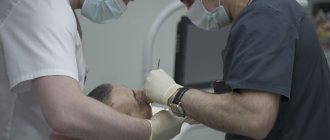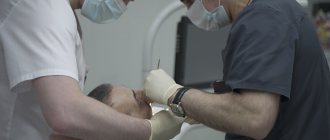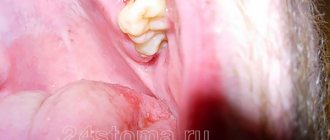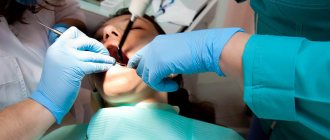Methods of modern dentistry are aimed at preserving the dental unit. Removal is resorted to as a last resort if gentle treatment techniques are ineffective. Resection of the apex of the tooth root (apicoectomy) is a microsurgical intervention for excision of tissue affected by infection with part of the injured tooth root. The operation is performed if the inflammation has taken the form of a cyst or granuloma. The main condition for the success of such a surgical intervention is the timeliness of the patient’s visit to the dentist. If the pathological process spreads to most of the root, the tooth will have to be removed.
Indications for surgery
- Poor endodontic treatment leading to inflammation of the root apex;
- the presence of a cyst, granuloma or other neoplasm, no more than 1 cm in diameter;
- perforation of the root walls during filling;
- pin or stump inlay in the dental canal;
- obstruction of the dental canal due to a congenital developmental defect;
- a crown or bridge placed on a tooth.
Contraindications to resection of the root apex
In some situations, surgery will have to be postponed. The most important condition is remission of the disease - if inflammation worsens, intervention is not performed, so the doctor will first prescribe a course of treatment to relieve acute symptoms.
Resection of the root apex is not performed if:
- mobility of teeth 2 and 3 degrees;
- exposure of the neck or root of the tooth (with periodontal disease);
- cyst size more than 1 cm - due to poor prognosis;
- exacerbation of chronic diseases;
- presence of crowns;
- diseases of the heart and blood vessels;
- endocrine pathologies;
- blood clotting disorders.
The doctor will not undertake to perform resection even if the tooth is severely damaged - this operation is designed to preserve the tooth and its functions, and if the tooth is affected by caries and cannot be restored with filling materials, the intervention is not performed.
If there is grade 1 tooth mobility, tooth displacement, or a formed gum pocket no more than 5 mm deep, gum resection may be recommended.
When surgery is not performed
Like any other surgical intervention, apicoectomy has limitations and contraindications. These include:
- Mobility of teeth II-IV degrees;
- destruction of the crown part of the tooth (more than 50%);
- the presence of cracks in the affected root;
- severe curvature of the root canal (impossible to fill);
- crowding of teeth, which does not allow identifying the affected root;
- acute infectious, viral disease;
- severe bleeding disorders;
- decompensated diabetes mellitus;
- severe immunodeficiency;
- oncology in the active stage.
Some of the limitations to root resection are the indication for removal of the affected unit. The second part refers to general contraindications to any surgical intervention. The risk of surgery for the patient is assessed individually.
The specialists at the Ilatan Clinic make every effort to save the dental unit, if possible. But if there are direct indications for removal, for example, extensive damage to dental tissue, the doctor will not suggest apicoectomy.
Advantages and disadvantages of the method
Each dental procedure has its own advantages and disadvantages. Resection of the apex of the tooth root is no exception.
Advantages of the technique:
- Preservation of the basic function of the tooth for an indefinite period of time.
- Removal of the infectious focus in a short time.
- Minimal trauma.
Disadvantages of the method:
- The emergence of a risk of complications associated with the need to fill canals in a previously untreated tooth. Our specialists minimize the risk of complications, as they perform the operation under a modern dental microscope. This device ensures high quality of the treatment process and eliminates the possibility of incomplete removal of infected tissue.
Resection stages
- Formation of access
- the dentist cuts through the gum, exposing the jaw bone. Forms a small hole in the bone tissue (in the projection of the root apex), gaining access to the pathological focus. Often, the bone tissue has dissolved in the projection of the cyst; there is no need to cut out a hole. - Excision of tissues and correction of the apex
- the doctor removes the source of inflammation along with the dead apex of the root, cutting it off perpendicular to the upper dental axis (to the level filled with the filling mass). The empty space is filled with osteoplastic material (bone volume is restored faster). - Suturing
- suturing the wound area is sometimes performed with the installation of drainage for the outflow of ichor. Drainage is installed between the seams and is removed after 1-2 days.
Root resection takes 40-60 minutes, depending on the location of the tooth. It is easier to intervene on canines and incisors than on multi-rooted units.
Operation procedure
- Tooth preparation. The root canal is filled at least two-thirds. If this is not possible, intraoperative retrograde filling is performed.
- Anesthesia. The operation is performed under local anesthesia.
- On the jaw at the location of the transitional fold, an incision is made to the bone. The mucosal flap is opened and peeled off using a special spreader.
- Using a cylindrical or spherical nozzle, the outer bone wall is removed.
- Having exposed the root tip, it is opened to the level of filling with filling material, which is easily identified by the white dot in the center of the cut.
- The bone cavity is thoroughly cleaned of granulomas, granulations, foreign bodies, and filling material.
- The sharp edges of the bones are ground using a milling cutter.
- Resection of the tooth root is carried out at the level of the bottom of the cavity. This is necessary so that the root section does not protrude. If necessary, retrograde filling of the canal is performed.
- The cavity is filled with a bone substitute and covered with a special membrane.
- The cut flap of mucous membrane is returned to its place, the wound is sutured.
- A pressure bandage is applied to the operated area for half an hour and cold is applied to minimize the manifestations of swelling and hematoma.
- After three to four months, the surgical site is overgrown with full bone tissue.
Recovery period
The entire operation lasts about an hour, the recovery period takes up to six months or more, depending on how quickly the bone tissue regenerates. In the first 1-2 days after the surgical procedure, the patient is bothered by moderate pain, swelling, and redness of the gums. After 3-4 days, the unpleasant symptoms decrease and the condition improves. To ensure that the postoperative period passes quickly and without problems, the doctor will give the necessary recommendations for care, prescribe painkillers, as well as a short course of antibiotic therapy.
Expert opinion
Igor Yurievich Malinovsky
Maxillofacial surgeon, implantologist
Experience: more than 11 years
In a modern dental clinic, the operation of resection of the root apex takes place very quickly and without pain for the patient. This procedure allows you to “save” a tooth from removal and save the patient from subsequent expenses - prosthetics, implantation, etc. If there is a chance that by cutting off the problematic part of the root, the doctor will save the tooth and the rest of the root, it is necessary to use it. The possibility of resection is determined by the condition of the root and surrounding tissues during diagnosis.
After tooth root resection
Recovery of injured tissue usually occurs within a week, but bone tissue requires a longer period - usually at least 3-4 months.
After the operation, unpleasant sensations such as swelling of the gums (dissipate after 2-3 days) and minor pain, especially when pressing and chewing food, may occur. Among the main complications that can be easily eliminated with medication or go away on their own are sinusitis or runny nose, damage to nearby nerves if the tumor was removed in the lower jaw. During the week after surgery, it is necessary to take antibiotics and vitamins to restore the body after infection and treatment.
Not many specialists undertake the resection operation, since it is not so much complex as it is labor-intensive and radical - after all, not only the cyst or granuloma is removed, but also part of the tooth. But you should not be afraid of the operation - the resection will be performed by experienced professionals who have extensive experience in this area.
Care after tooth resection
- Do not chew on the operated side.
- Until the wound heals, avoid irritating, solid foods (food should be warm and soft).
- Do not use a hard toothbrush, aggressive pastes, or mouthwash.
- Take antibiotics prescribed by your doctor to prevent infection.
- Rinse your mouth after eating with an antiseptic solution.
- For the first week after surgery, limit physical activity to moderate, and exclude extreme, contact sports.
- Do not visit the bathhouse, swimming pool, sauna until the wound is completely healed.
- Avoid eating too hard foods until the bone is completely restored (at least 3 months).
- Visit your surgeon regularly to evaluate the results of the operation.
After resection of the root apex
Swelling after resection of the root apex is a normal reaction of oral tissues to intervention. As a rule, this symptom goes away within 3–5 days if you follow your doctor’s recommendations.
It is recommended to refrain from physical activity for 24 hours after surgery. It is also important to follow other tips:
- Apply a cold compress to the intervention area for half an hour.
- Avoid eating for 2–3 hours after surgery.
- Carefully observe oral hygiene and use non-aggressive products - pastes and rinses.
- Give preference to soft, preferably semi-liquid food at a warm temperature. For the first few days, you should avoid spicy, salty, and sweet foods.
Swelling after resection of the apex of the tooth root can go away already on the 5th day, but rehabilitation in general takes from several days to one month. In order to prevent tissue infection, the doctor will prescribe medications: immunostimulants, antimicrobials, anti-inflammatory drugs, medications to relieve swelling.
Laser technologies have proven themselves well. The use of a laser after surgery allows tissue to recover faster, prevents bleeding and other complications of the intervention.
It is also not forbidden to rinse the mouth with herbal decoctions, antiseptics - chamomile, sage, miramistin, etc. It is important to regularly assess the condition of the tissues using x-ray diagnostics - it is better to do this every 3 months.
The outcome of the recovery period depends on how responsibly the doctor’s recommendations are followed—if you allow the inflammatory process to recur, you can lose a tooth. Its service life when following recommendations is determined by individual characteristics; as a rule, it can cope with its functions for a long time.
Possible complications
Root resection is a micro-operation, the purpose of which is to preserve the full functionality of the affected tooth. Usually, the risk of complications is minimal, but they cannot be completely excluded. Sometimes the following complications are possible:
- Bleeding due to injury to nearby vessels;
- infection of a postoperative wound;
- recurrence of cysts, granulomas (if all affected tissues were not removed);
- perforation of the maxillary sinus, nasal passage;
- damage to the nerve passing along the alveolar ridge;
Sometimes complications are caused by structural features of the jaw, for example, the proximity of the roots to the maxillary sinus. Complications caused by non-compliance with medical recommendations include swelling and tissue inflammation. Ignoring advice on limiting physical activity is fraught with the development of bleeding, and failure to maintain hygiene can lead to wound infection.
Complications that may appear after the procedure
In the first days after surgery, the patient may experience symptoms such as pain, swelling, and hyperemia of the mucous membrane. These consequences are normal and can accompany the patient for several days. This is due to the fact that resection quite seriously injures the tissues of the gums and jaw. That is why you should follow all the recommendations given by a specialist. Another normal option is the appearance of a hematoma or slight bleeding from the wound in the first 1-2 days after surgery. The amount of bleeding should be insignificant.
It is worth remembering that each patient’s body is individual and tolerates the rehabilitation period differently. One person may go about their usual activities, while another will feel weak and unwell, and will also notice an increase in body temperature. As a rule, all side effects should go away within 3-5 days.
Among the complications of root apex resection that are not normal are the following:
- Nerve damage. Signs of this complication are severe pain that does not go away for a long time, numbness of the soft tissues of the cheek, neck and other adjacent areas.
- Damage to the maxillary sinus. Typically, perforation occurs during resection of the upper jaw and subsequently requires long-term treatment.
- Spread of infection to the root system of an adjacent tooth. This can happen if the roots are too close. In this situation, it is necessary to stop the infection process in a timely manner.
- Relapse of pathology. The complication is a consequence of incomplete or poor-quality removal of infected tissue. Also, the cause of relapse may be incomplete filling of the dental canals before resection. In this case, the operation may need to be repeated.
Cost of tooth root resection
The price of root resection is determined depending on the volume of surgical intervention, the cost of consumables, and anesthesia. The result of the procedure fully justifies the money spent. After all, it is cheaper than removal with further implantation and prosthetics. The doctor will tell you exactly how much tooth resection costs after examination and diagnosis.










